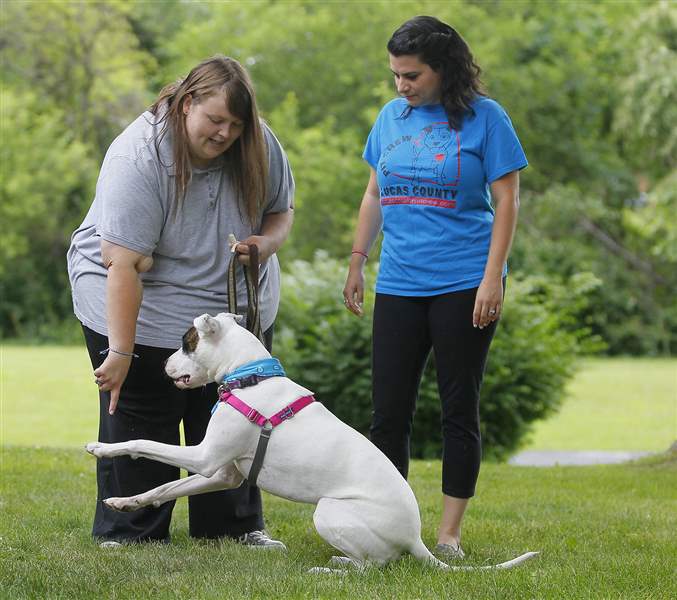
Animal lovers should not shy away from adopting deaf dogs
Owners, shelters offer tips, training in communication
7/10/2014
Lindsey, left, and Christina Reed work with their deaf dog Mari, at their Toledo home on July 3. Mari, a ‘pit bull’ mix was adopted a little more than a year ago from the Lucas County Pit Crew.
THE BLADE/ANDY MORRISON
Buy This Image

Lindsey, left, and Christina Reed work with their deaf dog Mari, at their Toledo home on July 3. Mari, a ‘pit bull’ mix was adopted a little more than a year ago from the Lucas County Pit Crew.
When most of the dogs at the Lucas County Canine Care & Control are barking excitedly for their breakfasts, two of them are often still sleeping peacefully in their own silent worlds.
Damon and Pinto, both white “pit bull” mixes, are deaf. They were born without pigment in the skin of their inner ears, which caused the nerve endings to die in the first few weeks of their lives.
“It’s a relatively common congenital defect in all-white dogs, particularly,” shelter Director Julie Lyle said. “We get them here from time to time.”
It is a little unusual for the shelter to have two deaf dogs at the same time, she said. Damon, estimated at 1 or 2 years old, came in as a stray May 26 and is up for adoption. Pinto, who is only 3 or 4 months old, was found June 17 as a stray. She was transferred recently to the Lucas County Pit Crew.
The shelter’s behavior technician, John Brown, said deaf dogs are normal in every way but their hearing.
“They are actually more relaxed and less stressed in a shelter environment because they don’t hear all the noise,” Mr. Brown said.
Training a deaf dog is not much different from training a hearing dog. The adjustment is simply learning to communicate with them using hand signals as opposed to vocal commands.
“The biggest thing is just getting their attention,” Mr. Brown said. “You need to teach them to look at you and check in with you.”
Angi Holt-Parks of Toledo adopted 2-year-old Rudi from the county shelter a little more than a year ago. The white “pit bull” mix knows about 15 commands in American Sign Language, has earned a Canine Good Citizen certificate, and is working toward becoming a certified therapy dog.
“She’s just been an absolute blessing,” Mrs. Holt-Parks said. “And she kept getting looked over at the shelter because she’s deaf.”
Mrs. Holt-Parks is a volunteer with the county shelter and with the Pit Crew. Rudi participates in the “pit bull” rescue’s Reading Buddies program, going to libraries so children can read to her. The children are often curious about Rudi’s deafness.

Damon is one of two deaf dogs up for adoption at the Lucas County Canine Care & Control.
“What I end up doing is showing them some sign language,” Mrs. Holt-Parks said. “And she’ll respond to them and they get really excited.”
Lindsey Reed and Christina Busuttil adopted Mari, a deaf white “pit bull” mix with a brindle eye patch, a little more than a year ago from the Pit Crew. Both women are speech therapists, and Ms. Busuttil often works with children who have hearing difficulties.
Learning how to get Mari’s attention and communicate with her through hand signals was actually easier for them than handling her puppy behavior.
To get a deaf dog’s attention without touch, owners can stomp on the floor, flip a light on and off, or make large gestures. Mrs. Holt-Parks sometimes uses a laser pointer with Rudi.
Mr. Brown said because deaf dogs cannot hear things approaching, they may be a little more likely to startle when touched unexpectedly, or in situations like being passed by a bicycle while out for a walk. But they can be conditioned to it using positive-reinforcement training.
“You really should do that with any dog,” he said. “Touch them when they aren’t looking and reward them with treats. Every time they startle and turn around, something good happens.”
Potential adopters shouldn’t hesitate to take a closer look at a deaf dog if its other attributes meets a family’s needs.
“Let them show you what they can and can’t do,” Ms. Busuttil said. “When we got [Mari], I thought, ‘She won’t be able to do this, or this, or this.’ But I was wrong about all those things.”
Contact Alexandra Mester: amester@theblade.com, 419-724-6066, or on Twitter @AlexMesterBlade.